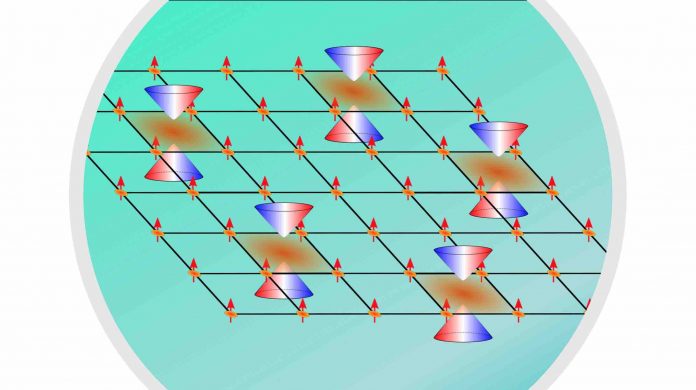Researchers at the U.S. Department of Energy’s Ames Laboratory have observed novel helical magnetic ordering in the topological compound EuIn2As2 which supports exotic electrical conduction tunable by a magnetic field. The discovery has significant implications for basic research into functional topological properties and may one day find use in a number of advanced technology applications.
Topological materials burst onto the scene in the physical sciences about fifteen years ago, decades after their existence had been theorized. Called ‘topological’ because their bulk electronic bands are “knotted” together, the surfaces of topological insulators “untie the knot” and become metallic. Researchers at the Ames Laboratory’s Center for the Advancement of Topological Semimetals (CATS) are seeking to discover, understand, and control the exceptional conduction properties of these materials.
Much of modern technology relies on crystalline materials, which are solids composed of a repeating (periodic) arrangement of atoms that forms a lattice. Due to the periodicity, the lattice looks the same after certain symmetry operations such as translation, specific rotations, mirror, and/or inversion. The existence or absence of these symmetries affect electronic band topology and surface electronic conduction. Magnetic ordering can modify the symmetries exhibited by the material, providing an additional means to control the topological state.
In collaboration with scientists at Oak Ridge National Laboratory’s Spallation Neutron Source, McGill University, and the University of Missouri Research Reactor Center, the CATS team discovered the existence of low-symmetry helical magnetic ordering in EuIn2As2 which supports a highly sought-after topological state called an axion insulator. This state shares similarities with the axion particle in quantum chromodynamics which is a candidate component of dark matter. In solid-state materials, it provides remarkable parallel coupling between magnetic and electrical properties.
In the presence of EuIn2As2’s complex helical magnetic ordering, the axion state leads to topological features in the surface electronic spectrum called Dirac cones. When a Dirac cone occurs on a surface of the material penetrated by a fundamental axis of the magnetic ordering, the cone has no energy gap and the surface exhibits resistanceless conduction tied to the orientation of the electronic spin. The other surfaces have gapped Dirac cones and support half-integer quantized electrical conduction. The researchers predict that application of a relatively moderate magnetic field switches which surfaces support which type of Dirac cone, allowing the surface conduction to be tuned.
The ability to switch between surface states by a magnetic field provides an experimental avenue to examine the unique properties of its topological states. This tunability is also promising for technologies such as high-precision sensors, resistanceless nanowires, magnetic storage media, and quantum computers. Future studies will look at bulk crystals while applying a magnetic field and will synthesize and study nanoscale-thin films in order to pave the way for technological applications.




